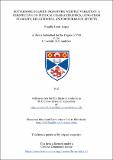Files in this item
Bottlenose dolphin signature whistle variation : a perspective on physical characteristics, long-term stability, relatedness, and disturbance effects
Item metadata
| dc.contributor.advisor | Janik, Vincent | |
| dc.contributor.author | Leon-Lopez, Braulio | |
| dc.coverage.spatial | xiv, 181 p. | en_US |
| dc.date.accessioned | 2017-05-23T14:59:42Z | |
| dc.date.available | 2017-05-23T14:59:42Z | |
| dc.date.issued | 2017-06-21 | |
| dc.identifier.uri | https://hdl.handle.net/10023/10819 | |
| dc.description.abstract | Bottlenose dolphin signature whistles are individually specific, modulated tonal sounds that have been the focus of interest for studying the social acoustic repertoire in this species. However, there is still limited understanding about the factors that might drive variation in these signals. The dolphin community in Sarasota Bay is ideal for investigating the influence of interspecific and intraspecific characteristics as well as the social structure on signature whistles as it has been a long-term study for over 30 years. In this thesis, I investigated whether sex, age and size affected the acoustic parameters and modulation patterns of signature whistles. I also determined the variation in signature whistle acoustic characteristics over a long period of time to test the stability of contour patterns. To look at the possible influence of genetic relationships on whistle structure, I studied the influence of maternal kinship (including mothers, grandmothers, siblings and aunts or uncles) and associations during the first year of life on signature whistle acoustic parameters and contour modulation patterns. Since short-term responses to environmental changes can also be encoded in whistles and can lead to changes in whistle parameters, I investigated the effect of carrying digital acoustic devices (D-TAGs) after brief capture-release session on the acoustic properties of signature whistles and dolphin behaviour. The overall results of this thesis highlighted that signature whistles are arbitrary signals that have long-term stability allowing them to be reliable signature calls. Mother-calf relations and social interactions during very early development were found to have the highest influence on the crystallisation of a signature whistle modulation pattern. Carrying suction cup D-TAGs, on the other hand, had no clear effect on the dolphins’ signature whistles and surface behaviour, confirming that these research methods are appropriate for studying vocal behaviour in bottlenose dolphins. | en |
| dc.language.iso | en | en_US |
| dc.publisher | University of St Andrews | |
| dc.rights | Attribution-NonCommercial-NoDerivatives 4.0 International | * |
| dc.rights.uri | http://creativecommons.org/licenses/by-nc-nd/4.0/ | * |
| dc.subject | Bottlenose dolphin | en |
| dc.subject | Signature whistles | en |
| dc.subject | Acoustic variation | en |
| dc.subject.lcc | QL737.C432L4 | |
| dc.subject.lcsh | Bottlenose dolphin--Vocalization | en |
| dc.subject.lcsh | Animal sounds | en |
| dc.title | Bottlenose dolphin signature whistle variation : a perspective on physical characteristics, long-term stability, relatedness, and disturbance effects | en_US |
| dc.type | Thesis | en_US |
| dc.contributor.sponsor | Consejo Nacional de Ciencia y Tecnología (CONACyT) (Mexico) | en_US |
| dc.contributor.sponsor | Mexico. Secretaría de Educación Pública. Dirección General de Relaciones Internacionales (DGRI-SEP) | en_US |
| dc.type.qualificationlevel | Doctoral | en_US |
| dc.type.qualificationname | PhD Doctor of Philosophy | en_US |
| dc.publisher.institution | The University of St Andrews | en_US |
The following licence files are associated with this item:
This item appears in the following Collection(s)
Except where otherwise noted within the work, this item's licence for re-use is described as Attribution-NonCommercial-NoDerivatives 4.0 International
Items in the St Andrews Research Repository are protected by copyright, with all rights reserved, unless otherwise indicated.


